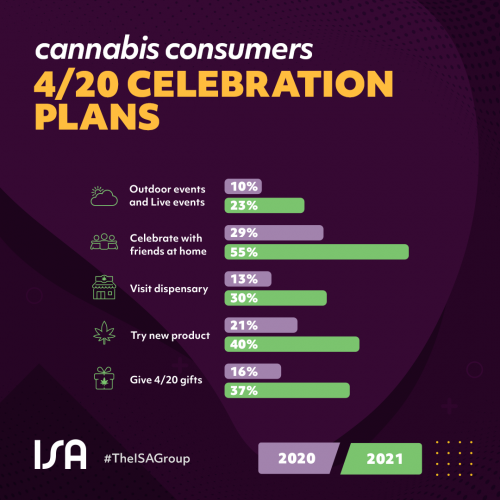Industry experts from Undefined Inc, Wana Brands and dreamt will discuss the future of infused edibles
ISA and Vertosa announced today the speaker lineup for their upcoming webinar “Form, Function & Flavor: Edibles for 2021 and Beyond.” Dorian Morris, Founder and CEO of Undefined Inc., Mike Hennesy, Vice President of Innovation at Wana Brands and Carolina Vazquez Mitchell, MS, Chief Science Officer at dreamt will join the live event starting at 2 pm PST on April 29, 2021. This engagement is the second in a series of webinar events stemming from a strategic partnership between ISA and Vertosa, announced in November 2020.
“Our speaker lineup brings together a diverse group of powerful industry leaders, each with their own unique perspective and in-depth knowledge of both the edibles market, and the cannabis industry as a whole,” said Jacqueline Rosales, President of ISA. Jacqueline will moderate the event and lead the conversation about product development in the edibles market and how the products of the future will fit into consumers’ lives. The event is free and open to the public. Attendees can register here.
In 2021, we’ve seen an explosion in new edibles products that address specific needs – sleep, anxiety, creativity, energy, diet support and immune support. Innovative brands are embracing new delivery forms, flavors and functions to meet consumers’ evolving interests.
“With stress at an all-time high, accessibly priced, plant-based solutions are even more important now,” said Dorian Morris, Undefined Beauty Founder and CEO. Morris was recently featured in the Target Takeoff Beauty cohort, in which she discussed her new collection, focused on adaptogenic mushrooms for stressed skin.
MEET THE SPEAKERS
Dorian Morris
Founder and CEO of Undefined Inc. A true champion of inclusivity within wellness, Dorian Morris is a beauty junkie with deep expertise across categories from cosmetics to haircare to skincare to food/wellness. She is the Founder/CEO of Undefined Inc which includes Undefined Beauty, a clean, conscious, inclusive lifestyle brand focused on democratizing wellness and destigmatizing plant magic.
Adriana Hemans
Vice President of Demand at ISA, where she heads up the Cannabis Research Division. She helps cannabis brands build more customer-centric businesses through data and insights. Adriana’s work has been published in numerous industry publications including mg Magazine, Marijuana Venture, and The Cannigma. She has been invited to speak onstage at cannabis events across the country, including NECANN (Northeast Cannabis Business Conference) and the NCIA’s Annual Cannabis Business Conference.
Austin Stevenson
Chief Innovation Officer at cannabis and hemp infusion technology company Vertosa. Austin plays an integral role in the business development of Vertosa, facilitating partnerships with leading brands to produce top quality cannabinoid-infused beverages, topicals, edibles and more. Prior to joining Vertosa, Austin leveraged his bio-tech experience building the regulatory Hemp/CBD testing program for Eurofins – a world leader in food, environment, and product testing services – where he worked with CVS and Walgreens to test and verify the quality of their retail CBD topicals. Austin and the Vertosa team are also committed to community action and industry leadership. He serves as a Member on the City of Oakland’s Cannabis Regulatory Commission, for which he supports the licensing of equity partners and works to break down financial barriers to entering the industry by championing grant funding. He is also an Advisory Board Member on EAZE’s Momentum Program, a business accelerator designed to support and empower underrepresented founders in the licensed cannabis industry, as well as a founding board member of the Cannabis Beverage Association.
Mike Hennesy
Vice President of Innovation at Wana Brands where he oversees their research and development program, new product design, educational training content and growing partnerships with new cannabis technologies. Hennesy led the team in creating Wana’s new Quick line of gummies and tinctures that use innovative encapsulation techniques to increase the bioavailability of cannabinoids that bypass liver metabolism and take effect quickly. He developed Wana’s online interactive training program for budtenders and employees that covers the science of the endocannabinoid system and directed the development of Wana’s vape line, including the line’s unique proprietary terpene blends.
Carolina Vazquez Mitchell, MS
Founder and Chief Science Officer at dreamt. A gifted academic with deep experience in the developing regulatory standards of the cannabis industry. Carolina’s areas of specialty include organic chemistry and biochemistry research, laboratory testing and laboratory practices, quality assurance, and R&D for cannabis products, pharmaceuticals, foods, and beverages. She has more than 10 years’ experience with organic synthesis and extractions and has extracted DNA, RNA, proteins, terpenes, and other pharmacologically active molecules. Carolina is a nationally recognized cannabis scientist, and has been a featured expert in Rolling Stone, HelloGiggles, mg and Forbes, and was named one of Dope Magazine’s “Outstanding Women in Cannabis.”
ABOUT VERTOSA
Vertosa creates industry-leading active ingredients for infused product makers. Their catalog of patented and patent-pending nano-emulsions are carefully designed for the specific needs of each customer, with pre-suspended aqueous solutions that create incredibly homogeneous and stable products while maximizing bioavailability, clarity, and taste. Vertosa works closely with their lab partners and clients of all sizes throughout the manufacturing process to achieve target potency and successfully bring consistent, reliable, quality infused products to market. Learn more about Vertosa at vertosa.com.
ABOUT WANA BRANDS
Wana Brands is the No. 1 edibles brand in North America. Wana leads the industry in quality, consistency and potency, providing a range of different options that enable customers to create the specific cannabis experience they want. Wana products offer diverse product forms, four different CBD/THC ratios as well as a variety of different dosages, onset times and duration of effects. The portfolio is designed so products can be used singly or in combination to address specific health, wellness, and recreational needs. Wana products are available in California, Colorado, Florida, Illinois, Maryland, Michigan, Missouri, Ohio, Arizona, Oregon, and Oklahoma dispensaries, with Massachusetts among the states imminently coming online. Wana Brands is available internationally in Canada. For more information or to subscribe to Wana’s e-newsletter, visit www.wanabrands.com.
ABOUT UNDEFINED INC
Undefined is clean, conscious, inclusive plant magic. We live at the intersection of wellness meets adaptogens (like beautiful CBD) meets purpose-driven conscious capitalism. My mission is to “undefine” and democratize beauty and destigmatize plant-based solutions through an unapologetic, uncompromising, unfiltered approach. Wellness shouldn’t be illusive or exclusive—let’s democratize it.
Undefined Inc partners with BIPOC founded, female-led, LGBTQ+ suppliers from their manufacturing partners to their creative team.
ABOUT DREAMT
dreamt is an award-winning sleep aid made with cannabis. The science-backed formula is a precise blend of THC, CBD, and other sleep-inducing compounds, such as melatonin, valerian root, and L-theanine. This unique formula was created by dreamt’s founder and Chief Scientific Officer, Carolina Vazquez Mitchell, to treat her insomnia during her chemistry PhD at USC.
dreamt is a female and minority-owned social equity business based in Los Angeles.







 “Alexa, let’s do a survey”
“Alexa, let’s do a survey” Beauty tech – look better, feel worse
Beauty tech – look better, feel worse Can Americans fall in love with a robot dog?
Can Americans fall in love with a robot dog?